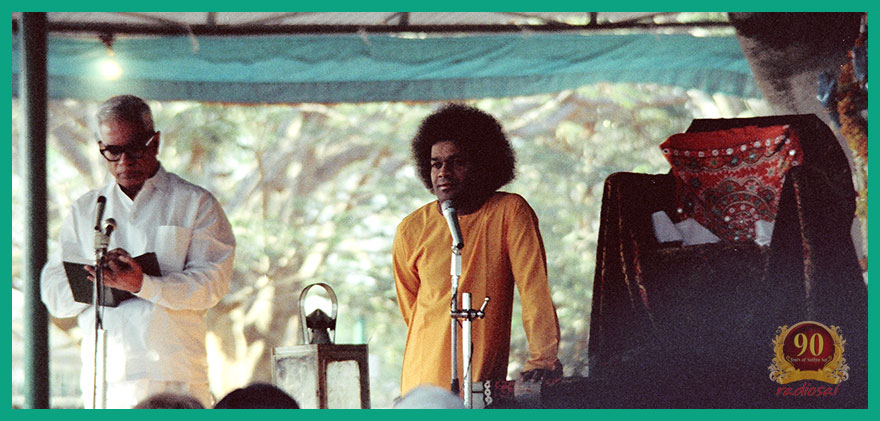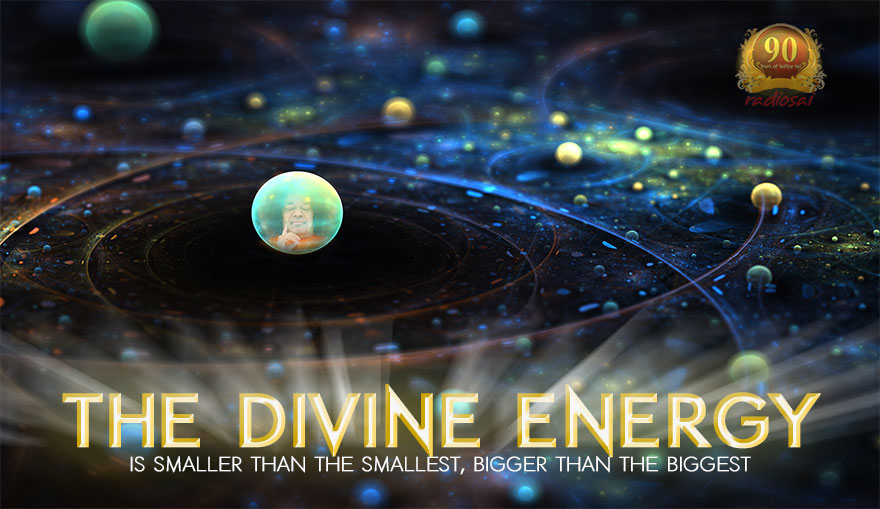|
|
| 'Like' us on Facebook | Follow us: |
Posted on: Apr 01, 2015
Sathya Sai Speaks - 90th Birthday Special
See the Real Hidden Behind the Unreal
19 November 1975
When the Lord comes in our midst there are two important aspects to His descent that stand out among others. One is His powerful and enchanting presence, which has the potency to transform and raise all who comes to Him. Everyone who comes to Him benefits, some considerably and few immensely, depending on one’s receptiveness. The other aspect is the message that He brings, and this has some unique benefits of its own. Adherence to the message has the power to manifest the Lord in one’s life. A tryst with Divinity could be a blessing for good acts of the past, but it is in loyalty to the message that one completely benefits and finds redemption, and also a means to express one's devotion to the Lord. So it is indeed of paramount importance for each of us to dwell on His message.
As part of the 90th Birthday offerings, we will begin every month with excerpts of a discourse from the Golden Jubilee Birthday Celebrations of Bhagawan. During the grand 50th Birthday celebrations, Baba gave discourses specific to the Seva wing and the Bal Vikas wing, apart from discourses revealing His own message and mission. The excerpts presented below are from the discourse Baba gave on 19 Nov 1975. Let us listen and re-listen, read and re-read even as we imbibe the essence contained.
The universal prayer begins with the words, Asatoma Sat Gamaya (Lead from the unreal to the Truth). In order to understand the true import of this prayer, it is necessary to delve on what exactly is 'reality'? How do we distinguish what is 'real' from the 'unreal'?Just because something is perceived (through the senses and mind), does not mean it is 'real' (genuinely exists). In mystical circles, believing the real to be unreal, and the unreal to be real is considered Maya (Illusion). One often needs to be jolted out of this Maya to understand 'reality'. During His discourse on 19 November, 1975, Bhagawan Sri Sathya Sai Baba delivered precisely this 'jolt'. That discourse is a treasure for every sadhaka (spiritual aspirant) and seeker of Truth. Bhagawan makes use of day-to-day examples to enlighten us with the Truth.
 |
Man's life begins everyday with the sun rise and ends with the sunset as he goes to bed. In fact, every living being in the world, spends life thus. Everyday sun rises in the east and sets in the west. Every time the sun appears on the horizon we observe it as the morning, and as soon as the sun sinks on the western side of the horizon we consider it evening. Based on this phenomenon (of appearance and disappearance of the sun) we determine what we call the east and the west. But when we look at it from a different perspective, say a person who has understood the fact that the Earth is a sphere, he will know that there is no east or west and in reality the horizon is one and undivided. Truly when you enquire into the matter in some depth, there is nothing like east or west, north or south. When the scientists go into this matter and establish this fact that, there is really no east or west or north or south, are they cognizant of this fact or are they still being led by their apparent vision which they had in the beginning – this we must ponder upon. The experience of life reveals one thing, but what really is, is quite different. When the plank on which we stand shakes a little or turns, we are also shaken. This is an everyday experience. While traveling in a car, bus or a cart, when it shakes, we also shake. This is a daily experience. When we see this from another perspective, the earth we are standing on is moving at a speed of many many miles per hour, yet we do not feel the motion.
So is that the truth or is this the truth? Is what we experience everyday the truth, or what we observe in nature the truth? People who have studied these matters have spent a lot of time in trying to answer these questions. Many investigators who have gone into this matter and who have recognized and accepted the fact that the earth is revolving and going round, are unable to establish as an experience if we too are moving with the Earth. This means that, what we experience in this world is one thing and there is another which is the basis and the cause for all this.
We are often told the insightful story of King Janaka's dream. There are many variants of the story and one variant goes like this:
One evening, Emperor Janaka returns late to his chamber. Welcoming the monarch, his Queen asks him to freshen up and get ready for dinner. Janaka nods as if to say yes but, overcome by exhaustion, slumps into a chair and dozes off. During his nap, he has a disturbing dream from which he later wakes up with a start. As he looks around, the scene is very different from what he was seeing just moments ago – no forest, no tiger chasing him, etc. Puzzled, Janaka begins to ask, “Is that real, or is this real?”
 |
He then enters a stupor, constantly repeating the same question. Palace medics are summoned but they are unable to help. Ultimately, the assistance of Sage Vasishta is sought and when he arrives, Janaka is still asking the same question. With a smile on his face the Sage places his hand on Janaka’s shoulder and gently observes,
“O king, neither is real; you alone are!”
 |
Vasishta was of course referring to the Atma within, dismissing what is experienced both in the waking as well as in the dream state as illusory. In other words, Vasishta was telling Janaka that what is Real lies beyond the experience of the senses and the thoughts of the Mind, both of which are transient. Vasishta was a man of wisdom and could clearly distinguish the real from the unreal. Bhagawan further dilates on what this wisdom is.
Wisdom is that, which enables one to perceive what lies hidden behind that which can be obviously seen. It is indeed necessary that all must try and find out the truth that lies behind all that you see as a manifestation in this world. Our ancestors, undertook many different forms of penance, and recognised the truth; and convinced that there is something which forms the basis to all that is seen, they propagated this message ever since. But since such conviction is lacking in the scientists of today, based merely on their external perceptions and objects of the world, they declare such and such is the truth and untruth.
Little wonder that Swami would often exclaim, "Pashyannapi Na Pashyati Mudho Mudho Mudho" - meaning, "You see and yet you do not see you fool, fool, fool!"
While ignorance can be forgiven, refusing to see something that is staring us in the face is absolute foolishness. It is akin to the silliness of a man searching for his spectacles all over the room while it sits on his very head! Swami gives another simple yet strong example to highlight how we see and yet do not see.
If we look from a different perspective, we state that here is a wall. How do we call it a wall? Considering its height, thickness and the fact that a person on this side of it cannot go to the other side through it, we say that this is a wall. Based on these three observations we have concluded thus. But it is not a wall when we look at it from a different perspective, it is a collection or assembly of atoms. Not only this, the empty space within these atoms is more (than the solid matter). So from a scientific perspective if investigated and seen, it is more like the stars scattered in the sky or space. When we look at the sky, we see more empty space than stars. So this is not a wall; this is simply a conglomeration of a large number of small particles with several wide spaces and passages in between. The scientists accept this explanation but will they accept if we say that this is not a wall? Scientists too call this a wall, so what is the truth, this or that? Since all these basic particles or atoms have emerged from the primordial energy, it is believed that they too possess the same energy and thus the declaration is made by the Vedas, 'Anoraneeyan Mahatho Maheeyan – (the Divinity or Divine Energy) is smaller than the smallest, bigger than the biggest!
 |
As Swami clearly states, this power is latent in the smallest of the small and the largest of the large. The extent of its expression may vary but that, in no way, changes the truth about its presence. Once again, our perceptions and notions come in the way of recognising this 'ONE' power latent in all things big and small; they obstruct our ability to see the existing unity in the apparent diversity. Once again, with all love and empathy, Swami provides an example to make this clear.
There is another small example for this. We bring a tumbler of water from the ocean. When we put a small pebble into this tumbler of water, the water gets separated and the pebble penetrates the water and goes down. The phenomenon does not consist in the pebble going down alone; the pebble causes several waves on the surface of the water and in the body of the water too. This water in the tumbler has also got a life force in it. The same water is present in the ocean. But there is no harm or danger that is caused by the movement or by the waves that are set up in the quantity of water that is in the tumbler. But in the ocean, when there is strong wind or a stormy gust, the water then develops such powerful waves, that the waves can even sink or break massive ships. Where from did the waters get this immense power or strength? In other words the inherent strength in the water of the ocean is so much, but in the case of the tumbler the power present is very tiny. But in both cases it is the power and the strength of the small particles or atoms. Similarly this power and strength may be feeble in some individuals, in some others it is very powerful. Hence if we come to the conclusion that, in certain material there is power and in some others there is no power it is a mistake.
What comes through this discourse and all the others delivered by Bhagawan is the love of a mother trying to counsel her child, the desperation of a friend trying to help his friend make the right choices and of course, the firmness and detached sternness of the Sadguru. But this profound discourse does not end here. It is further embedded with gems divine which we shall unearth, examine and delight in the next time.
- Radio Sai Team
What are your impressions about this Article? Please let us know by writing in to h2h@radiosai.org or you may leave your thoughts in the comments section. Do not forget to mention your name and country.
| comments powered by Disqus |






